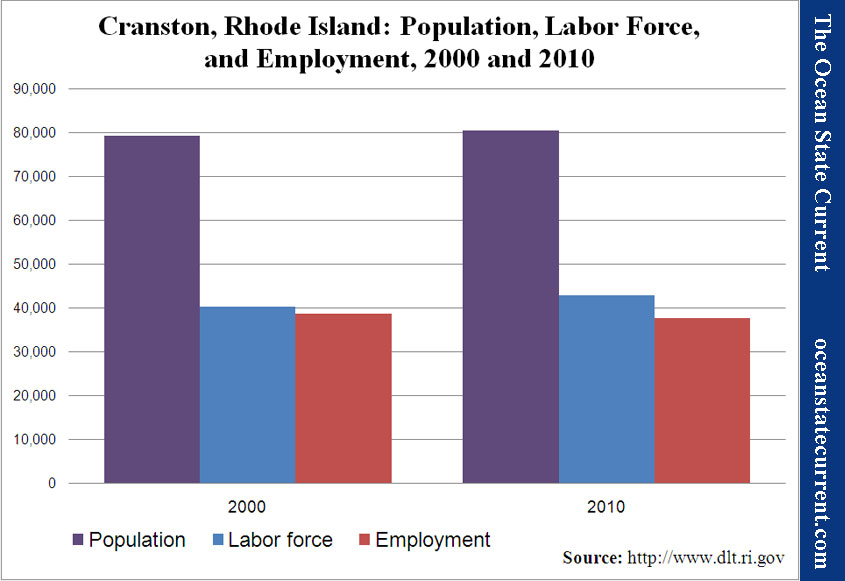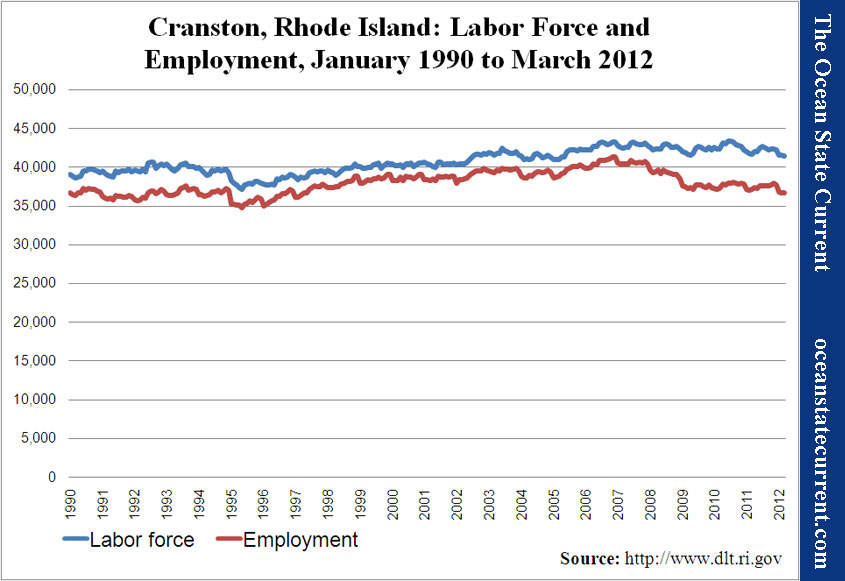State in Decline, Employment in RI Cities and Towns: Cranston
Cranston’s not-seasonally-adjusted unemployment rate for March clocked in just below the state’s average, at 11.5% versus 11.8%. Where the city’s employment data is particularly interesting, though, is in its comparison with neighboring Warwick.
Of the cities and towns that the Current has thus far reviewed, only Barrington and Jamestown had lower unemployment rates in March than Warwick’s 10.1%. However, the trends from the 2000 U.S. Census to the 2010 Census may provide some explanation of why the two cities south of Providence differ so much.
Over that period, Warwick lost population, and its labor force increased by only 0.6%, which helped to compensate (unemployment-wise) for the 7.2% drop in actual residents with jobs. In Cranston, by contrast, the population grew 1.4%, and the labor force expanded by 6.2%. So, even though the city’s number of employed residents fell less (2.3%) its unemployment rate grew much more quickly. Cranston started the millennium with an annual average unemployment rate of 4.2%, to Warwick’s 3.8%. (All numbers not seasonally adjusted.)
Of course, that shouldn’t by any means be taken to indicate that Cranston is doing well. As the following chart shows, the city’s labor force is well above its twenty-two-year average, while its number of employed residents is well below. Consequently, its number of unemployed residents is only 11% below the record set in various months of 2010.
Unemployment is the distance between the two lines.
Note on the Data
The population data above comes from the U.S. Census conducted every ten years and is therefore generally considered reliable, to the extent that is used as reference for various government programs and voter districting.
The labor force and unemployment data, however, derives from the New England City and Town Areas (NECTAS) segment of the Local Area Unemployment Statistics (LAUS) of the federal Bureau of Labor Statistics (BLS). A detailed summary of the methodology is not readily available, but in basic terms, it is a model based on and benchmarked to several public surveys. It can be assumed that the sample rate (i.e., the number of people actually surveyed) in each Rhode Island town is very small (averaging roughly 30 people per municipality).
The trends shown, it must be emphasized, are most appropriately seen as trends in the model that generally relate to what’s actually happening among the population but are not an immediate reflection of it. Taking action on the assumption that the exact number of employed or unemployed residents shown corresponds directly to real people in a town would vest much too much confidence in the model’s accuracy.
Be that as it may, the data has been collected and published, and taken a town at a time, it is relatively easy to digest. So, curiosity leads the Current to see it as the best available data to deepen our understanding of trends within Rhode Island. If the findings comport with readers’ sense of how the towns relate to each other, perhaps lessons regarding local and statewide policies may be drawn. If not, then the lesson will be on the limitations of data in our era of information overload.





